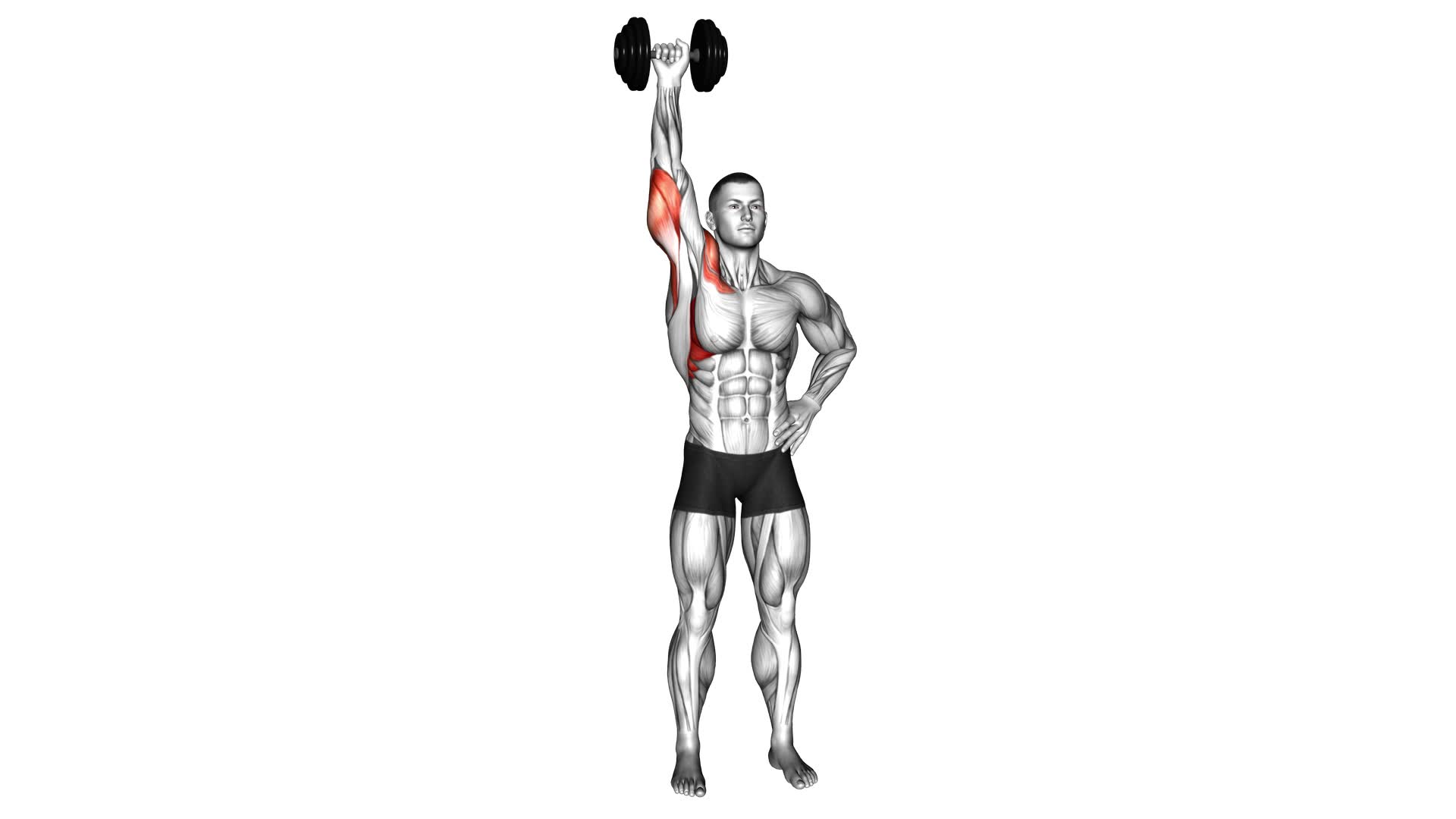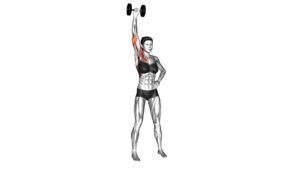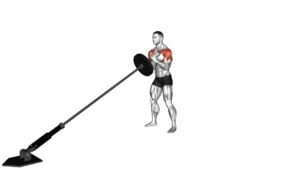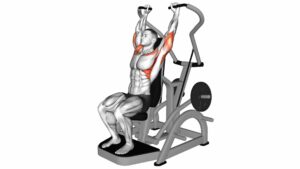Dumbbell One Arm Shoulder Press (VERSION 2) – Video Exercise Guide & Tips

Are you looking to strengthen and sculpt your shoulders? Look no further than the Dumbbell One Arm Shoulder Press (Version 2). This exercise targets your deltoids and helps improve overall shoulder strength.
Watch This Exercise Video
In this video exercise guide, we'll show you the proper form and technique, variations for all fitness levels, and common mistakes to avoid. Plus, we'll share tips to maximize shoulder growth.
Say goodbye to weak shoulders and hello to a more defined upper body. Let's get started!
Key Takeaways
- Increased shoulder strength
- Improved stability in the shoulder joint
- Targets shoulder muscles specifically
- Addresses muscle imbalances between left and right sides
Benefits of the Dumbbell One Arm Shoulder Press (Version 2)
You will experience increased shoulder strength and improved stability with the Dumbbell One Arm Shoulder Press (Version 2). This exercise specifically targets your shoulder muscles, helping to develop greater stability in the joint. By working each arm independently, you can address any muscle imbalances that may exist between your left and right sides.
Shoulder stability is crucial for proper movement and function in daily activities as well as sports and fitness exercises. The Dumbbell One Arm Shoulder Press (Version 2) requires you to stabilize your shoulder joint while lifting the weight overhead, which helps strengthen the muscles responsible for this stability.
Muscle imbalances occur when certain muscles are stronger or weaker than their opposing muscles. This can lead to poor posture, increased risk of injury, and reduced performance. By performing the Dumbbell One Arm Shoulder Press (Version 2), you can correct these imbalances by ensuring that each arm is working independently and equally. This exercise promotes balanced strength development, allowing you to achieve optimal shoulder stability and function.
Incorporating the Dumbbell One Arm Shoulder Press (Version 2) into your workout routine can greatly benefit your shoulder stability and help address any muscle imbalances you may have. It's important to perform the exercise with proper form and gradually increase the weight as you become stronger. Consult with a fitness professional if you have any concerns or questions about incorporating this exercise into your training program.
Proper Form and Technique for the Exercise
To ensure proper form and technique for the Dumbbell One Arm Shoulder Press (Version 2), it's important to focus on maintaining a stable shoulder joint throughout the exercise. Proper form is crucial to prevent injury and maximize the effectiveness of the exercise.
Start by standing with your feet shoulder-width apart and holding a dumbbell in one hand. Keep your core engaged and your back straight. Begin the exercise by raising the dumbbell to shoulder height, using your bicep to curl it up.
Next, press the dumbbell overhead, fully extending your arm while keeping your elbow slightly bent. As you press, be mindful of keeping your shoulder stable and avoiding any excessive movement or rotation. This will help to target the shoulder muscles more effectively.
Lower the dumbbell back to shoulder height in a controlled manner, maintaining proper form and shoulder stability. Repeat the exercise for the desired number of repetitions, then switch sides to work the other arm.
Remember to start with a lighter weight and gradually increase as you become more comfortable with the exercise. By focusing on proper form and maintaining shoulder stability, you can maximize the benefits of the Dumbbell One Arm Shoulder Press (Version 2).
Variations and Modifications for All Fitness Levels
As we delve into the variations and modifications for all fitness levels, let's explore how you can tailor the Dumbbell One Arm Shoulder Press (Version 2) to meet your individual needs and goals.
Here are some variations and modifications to consider:
- Weight selection: Adjust the weight of the dumbbell based on your strength and fitness level. Start with a lighter weight and gradually increase as you progress.
- Hand positioning: Experiment with different hand positions to target different muscles. You can try a neutral grip, palms facing in, or palms facing forward.
- Stability modifications: If you have trouble maintaining balance or stability, try performing the exercise seated on a stability ball or bench. This can provide additional support and reduce the risk of injury.
- Range of motion: If you have limited shoulder mobility or are recovering from an injury, you can modify the exercise by reducing the range of motion. Start with a partial press and gradually increase as you gain strength and flexibility.
Remember to always listen to your body and consult with a fitness professional or healthcare provider before attempting any new exercises or modifications.
Common Mistakes to Avoid During the Exercise
To ensure proper form and maximize the effectiveness of the dumbbell one arm shoulder press, there are a few common mistakes to avoid.
First, be mindful of keeping your elbows too wide during the exercise, as this can strain your shoulders and decrease stability.
Additionally, maintain a straight and upright posture to avoid rounding your back, which can lead to muscle imbalances and potential injuries.
Lastly, avoid lifting weights that are too heavy for you, as this can compromise your form and increase the risk of injury.
Elbows Too Wide
Avoid positioning your elbows too wide when performing the dumbbell one arm shoulder press. This common mistake can negatively impact your elbows position and shoulder stability, leading to potential injuries and decreased effectiveness of the exercise.
Here are some reasons why you should avoid wide elbows during the dumbbell one arm shoulder press:
- Increased stress on the shoulder joint: Wide elbows can cause excessive strain on the shoulder joint, increasing the risk of discomfort and injury.
- Limited range of motion: Positioning your elbows too wide restricts your range of motion, preventing you from fully engaging the shoulder muscles.
- Decreased stability: Wide elbows make it harder to stabilize the weight, compromising your form and reducing the effectiveness of the exercise.
- Imbalanced muscle activation: When your elbows are too wide, certain shoulder muscles may become overactive while others are underutilized, leading to muscle imbalances.
Now that we've covered the issue of elbows being too wide, let's move on to the next common mistake: rounded back posture.
Rounded Back Posture
When performing the dumbbell one arm shoulder press, it's important to maintain proper posture, particularly avoiding a rounded back position. A rounded back posture can put excessive strain on your spine and compromise the effectiveness of the exercise. To avoid this, focus on keeping your chest lifted and your shoulder blades pulled back and down throughout the movement. This will help to maintain a neutral spine alignment.
Additionally, having good shoulder mobility is essential for performing the exercise correctly. If you have limited shoulder mobility, it may be necessary to decrease the weight or modify the exercise until you can execute it with proper form.
Lifting Too Heavy
Maintaining proper form and avoiding excessive strain on your muscles is crucial when it comes to lifting too heavy during the dumbbell one arm shoulder press. By following the correct lifting technique, you can prevent injuries and maximize the effectiveness of the exercise.
Here are four common mistakes to avoid:
- Using too much weight: It's important to start with a weight that you can comfortably lift and gradually increase it over time.
- Sacrificing form for weight: Focus on maintaining proper posture, keeping your core engaged, and avoiding any jerking or swinging motions.
- Overarching your back: Keep your spine neutral throughout the movement to prevent unnecessary strain on your lower back.
- Neglecting warm-up and cooldown: Properly warming up your muscles before the exercise and stretching afterward can help prevent muscle imbalances and injuries.
Tips for Maximizing Shoulder Strength and Muscle Growth
To maximize your shoulder strength and muscle growth, focus on proper form and gradually increase the weight you're lifting. In addition to performing exercises like the Dumbbell One Arm Shoulder Press, incorporating shoulder mobility exercises and shoulder stability exercises into your routine can help optimize your results.
Shoulder mobility exercises, such as arm circles and shoulder dislocations, can improve the range of motion in your shoulders. These exercises help to loosen up tight muscles and prevent stiffness, allowing for better movement during your workouts. By increasing your shoulder mobility, you can perform exercises with proper form, which maximizes the effectiveness of the exercise and reduces the risk of injury.
Shoulder stability exercises, such as scapular retractions and prone Y's, focus on strengthening the muscles that support your shoulder joint. These exercises help to stabilize the shoulder and prevent it from moving excessively during exercises. By improving shoulder stability, you can enhance your overall shoulder strength and reduce the likelihood of shoulder injuries.
Remember to start with lighter weights and gradually increase the load as your strength improves. This progressive overload approach challenges your muscles and promotes muscle growth over time. However, be mindful not to lift too heavy too soon, as it can compromise your form and increase the risk of injury.
Sample Workout Routine Incorporating the Dumbbell One Arm Shoulder Press (Version 2)
When it comes to working out your shoulders, incorporating exercise variations is key to target different muscle groups and prevent plateaus.
One-arm exercises, like the dumbbell one arm shoulder press (Version 2), offer several benefits such as increased stability and improved muscle imbalances.
Exercise Variations for Shoulders
You can incorporate the Dumbbell One Arm Shoulder Press (Version 2) into your sample workout routine to add variety and challenge to your shoulder exercises. Here are some exercise variations for shoulders that you can try:
- Arnold Press: Start with the dumbbells at shoulder level, palms facing your body. As you press the weights up, rotate your palms to face forward at the top.
- Seated Dumbbell Lateral Raise: Sit on a bench with your back straight and hold the dumbbells by your sides. Raise the weights out to the sides until your arms are parallel to the floor.
- Bent-Over Rear Delt Raise: Bend forward at the waist with a slight bend in your knees. Hold the dumbbells with your palms facing each other and raise your arms out to the sides, squeezing your shoulder blades together.
- Standing Upright Row: Hold the dumbbells in front of your thighs with your palms facing your body. Lift the weights straight up, keeping them close to your body, until your elbows are higher than your shoulders.
By incorporating these exercise progressions and shoulder stability exercises into your routine, you can enhance your shoulder strength and stability.
Now, let's move on to the benefits of one-arm exercises.
Benefits of One-Arm Exercises
To enhance your shoulder strength and stability, incorporate the benefits of one-arm exercises into your sample workout routine that includes the Dumbbell One Arm Shoulder Press (Version 2).
One-arm exercises offer several advantages, including injury prevention and addressing muscle imbalances. By performing exercises with one arm at a time, you can identify and correct any asymmetries between your left and right sides. This ensures that one side of your body isn't compensating for the other, reducing the risk of injuries.
Additionally, one-arm exercises engage your core muscles to maintain stability and balance, further enhancing your overall strength.
Incorporating one-arm exercises like the Dumbbell One Arm Shoulder Press (Version 2) into your routine can help you achieve better shoulder strength, prevent injuries, and improve muscle balance.
Frequently Asked Questions
How Many Sets and Reps Should I Do for the Dumbbell One Arm Shoulder Press (Version 2)?
To determine the number of sets and reps for the dumbbell one arm shoulder press (version 2), consider shoulder press variations and the benefits of dumbbell exercises.
Tailoring the workout to your fitness level and goals is essential. Consult a fitness professional or trainer for personalized guidance. They can help you determine the appropriate number of sets and reps based on your current fitness level and desired outcomes.
Can I Perform the Exercise Standing Instead of Seated?
Yes, you can perform the one arm shoulder press standing instead of seated.
This variation of the exercise provides several benefits. By standing, you engage more stabilizer muscles and increase core activation.
Additionally, it mimics functional movements you may encounter in daily activities or sports.
However, it's important to maintain proper form and control throughout the exercise to avoid injury. Remember to start with lighter weights and gradually increase as you become more comfortable and confident.
Are There Any Alternative Exercises That Target the Same Muscle Groups as the Dumbbell One Arm Shoulder Press (Version 2)?
There are several alternative exercises that target the same muscle groups as the dumbbell one arm shoulder press (version 2).
These exercises include the barbell shoulder press, seated dumbbell shoulder press, and Arnold press.
These exercises focus on strengthening the deltoids, trapezius, and triceps.
Incorporating these alternative exercises into your workout routine can provide variety and help to further develop and strengthen the muscles in your shoulders and upper body.
Can I Use a Resistance Band Instead of Dumbbells for This Exercise?
Yes, you can use a resistance band instead of dumbbells for the one arm shoulder press. Using a resistance band can provide similar benefits as using dumbbells, such as strengthening your shoulders and arms.
However, there are some drawbacks to using a resistance band, such as limited resistance options and less stability.
To properly use a resistance band for the one arm shoulder press, anchor the band securely and maintain proper form throughout the exercise.
Is It Safe to Perform the Dumbbell One Arm Shoulder Press (Version 2) if I Have a Shoulder Injury?
Before performing the dumbbell one arm shoulder press (version 2) with a shoulder injury, it's important to consult a doctor. They can provide personalized advice based on your specific condition.
If you have a shoulder injury, modifying the exercise may be necessary to avoid aggravating it further. A healthcare professional or a qualified fitness trainer can guide you on how to modify the exercise to suit your needs and prevent any potential harm.
Conclusion
In conclusion, the Dumbbell One Arm Shoulder Press (Version 2) is a highly effective exercise for strengthening and building shoulder muscles. By following proper form and technique, individuals can prevent injury and maximize their results.
This exercise can be modified to suit all fitness levels, allowing beginners and advanced athletes alike to benefit from it. Avoiding common mistakes and incorporating this exercise into a well-rounded workout routine can help individuals achieve optimal shoulder strength and muscle growth.

Author
Years ago, the spark of my life’s passion ignited in my mind the moment I stepped into the local gym for the first time. The inaugural bead of perspiration, the initial endeavor, the very first surge of endorphins, and a sense of pride that washed over me post-workout marked the beginning of my deep-seated interest in strength sports, fitness, and sports nutrition. This very curiosity blossomed rapidly into a profound fascination, propelling me to earn a Master’s degree in Physical Education from the Academy of Physical Education in Krakow, followed by a Sports Manager diploma from the Jagiellonian University. My journey of growth led me to gain more specialized qualifications, such as being a certified personal trainer with a focus on sports dietetics, a lifeguard, and an instructor for wellness and corrective gymnastics. Theoretical knowledge paired seamlessly with practical experience, reinforcing my belief that the transformation of individuals under my guidance was also a reflection of my personal growth. This belief holds true even today. Each day, I strive to push the boundaries and explore new realms. These realms gently elevate me to greater heights. The unique combination of passion for my field and the continuous quest for growth fuels my drive to break new ground.







